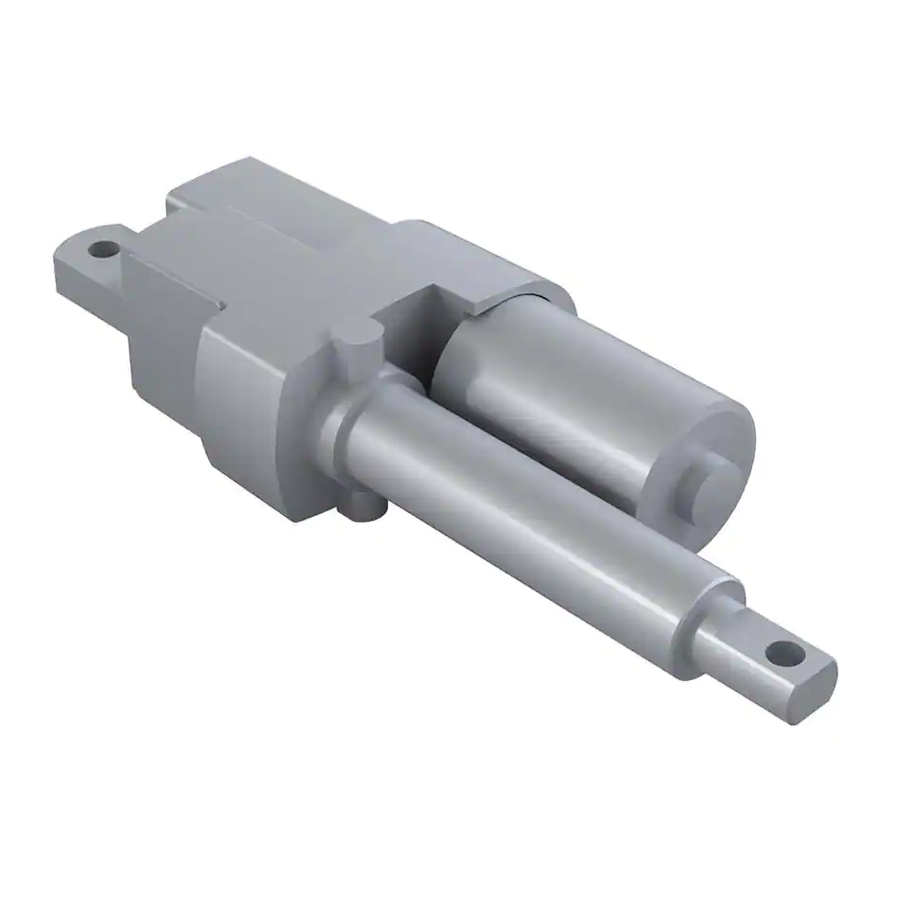Duff-Norton 6415 Series Manual de instrucciones de instalación, funcionamiento y mantenimiento - Página 8
Navegue en línea o descargue pdf Manual de instrucciones de instalación, funcionamiento y mantenimiento para Controlador Duff-Norton 6415 Series. Duff-Norton 6415 Series 16 páginas. Electromechanical linear actuators

17. Remove bearing (28), bushing (34) and flange
bearing (25) from cover (9).
Bushing (34) and flange bearing (25) should not be
removed unless they are damaged. Bearing (28) may
stay on pinion (29) and can be removed in Step 18.
18. Remove thrust washer (31) from intermediate pinion
shaft (32). Bearing (28) from pinion (29), thrust
washers (35) and thrust bearing (36) from spacer nut
(37) may have been removed in Step 10.
19. Remove spring (61) from end of screw (62).
20. Remove intermediate cluster gear (33), intermediate
pinion shaft (32) and thrust washer (31).
21. Remove socket head cap screws (45), lock washers
(46) and disassemble motor (53) from housing (42).
Care must be taken not to damage motor lead wires.
22. Remove "O"-Ring (52) and rubber grommet (50).
23. Disassemble outer tube (55) and slip off over
translating tube and clevis (66).
24. Remove air vent (58), wiper scraper (60) and guide
bushing (59) from outer tube (55).
If wiper scraper or guide bushing are not damaged they
should not be removed.
25. Remove set screw (68) from spacer nut (37) and
disassemble spacer nut (37) from screw (62) by
clamping screw (62) between soft jawed vise.
Care must be taken not to damage bearing journal of
spacer nut (37).
26. Remove output gear (39), key (40), thrust washers
(35), thrust bearing (36), and gear spacer (43).
27. Remove screw (62), translating tube and clevis (66)
and nut assembly (64).
28. Remove washer (44) from screw (62).
29. Thread screw (62) into the translating tube until the
screw bottoms out and cannot rotate farther, or until
the screw thread becomes disengaged from the
lifting nut thread (64).
30. Drive the four pins (65) just far enough into the
lifting nut (64) to clear the translating tube wall; then
remove the translating tube from the nut.
NOTE
WARNING
NOTE
WARNING
31. Remove the lifting screw (62) from the lifting
nut (64).
32. Remove the four pins (65) by pressing each one the
rest of the way through the lifting nut wall.
33. Remove the stop pin (63) from the lifting screw (62)
if necessary.
34. Removing the brake (49) .(Required only if drift is
excessive. If brake removal is not necessary, proceed
to Step 35).
a. Push on the pinion(29) and coupling (47) until it
slips back enough to make the spring (49) tang
accessible.
b. Remove the spring (49) by grabbing the tang
with pliers and twisting out. (Spring must now be
replaced and can no longer be used.)
c. Remove the brake insert (51). Remove retaining
ring (48) from input pinion (29). Input pinion
(29) and bearing (30) can now be removed from
housing (42).
d. The brake inset (51) has straight knurls on its
O.D. which prevent it from rotating. Therefore,
the insert can only be removed by pulling
straight out.
e. One method of removing the insert (51) is to use
a blind hole bearing puller. This tool expands into
the internal spring cavity and pulls against the lip
of the insert (51).
35. If coupling (47) on motor (53) shaft must be replaced,
remove retaining ring (48) from motor (53) shaft and
remove coupling (47).
DISASSEMBLY IS COMPLETE.
4-5. Assembly
Assemble the actuator as follows while referring to Figure
5-1. Read instructions thoroughly before assembling.
Be sure all components are clean and dry before
assembling.
1. Assemble coupling (47) on motor shaft, then install
retaining ring (48) on motor shaft.
2. Press bearing (30) on input pinion (29) (press load
should be applied to inner race of bearing to avoid
damage to bearing).
3. Press bushing (34) into housing (42).
4. Install input pinion (29) and bearing assembly (30)
in housing (42) (press load should be applied to
outer ring of bearing to prevent damage to bearing).
8
NOTE
